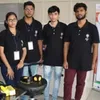Engineering students at Smart India Hackathon design a bot to ease ICU nurses' work
'Nurse Joy’ made by Team Whack1 from Bharati Vidyapeeth’s College of Engineering helps reduce the burden on ICU nurses by aiding them in their day-to-day duties.
Oft sidelined yet always ready with a helping hand, nurses are mostly overlooked in the larger scheme of care giving. A few college students from Delhi decided to give these hardworking and dedicated doctors' assistants some assistance of their own. They developed a bot that assists nurses in a patient’s critical care in ICUs at the Smart India Hackathon 2019-hardware edition. For this, they won a cash prize of Rs 1 lakh.
Team Whack1 from Bharati Vidyapeeth’s College of Engineering, Delhi developed a bot called Nurse Joy at the hackathon held at SRM Chennai.

Team whack1
Nurse Joy combines the mind of a nurse, and the manpower and might of a bot. The bot mimics every action made by the nurse. The nurse has to wear a jacket, which has a kill switch that allows the nurse to control the bot, and also aid her in holding a patient in a particular position.
It is fitted with cameras trained on a pose-estimation model, which detects different joints, and accordingly adjusts to lift the patient. It is also trained to reduce sudden jerky movements which can harm a patient.
The product also has an Android application that allows the nurse to easily move the bot via a joystick. The application also has a QR code scanner that helps the nurse in inventory management. Nurse Joy was designed to give the overworked nurse full assistance, so she can devote complete attention to her ICU patients.
How the nurse became bot
The product was developed by six engineering students - Abhay Sheel Anand (21) (who was the team leader), Shivansh Garg (20), Ujjwal Aggarwal (19), Shivam Grover (20), Surbhi Kumari (19) and Kshitij Sidana (19).
“The idea of controlling a bot has always been a dream for every member in the team. The original idea was to use potentiometers to get information on every finger movement. As we investigated the problem statements, an idea struck – we could control the bot’s arm. After thorough discussions, we modified it from potentiometers to using IMUs (inertial measurement unit) for precision, which also provided us control of the bot’s upper body, through someone wearing a jacket,” says team leader Abhay.
To understand what it takes to be a nurse in an ICU, the team visited Indraprastha Apollo Hospitals, and interviewed the head nurse. They realised that nurses face many challenges daily. Burdened with innumerable duties, they have little time to take care of critically ill patients. Lifting a patient who is either unconscious or heavy (it sometimes takes up to three individuals to lift a patient) can sap a nurse’s energy. As the ICU has many invalid patients, a nurse has a slew of tasks, and forgetting even one can be life threatening. The bot thus serves the purpose of an assistant to help lift patients, move them, etc.
The bot that cares
Nurse Joy aims to reduce a nurse’s stress, and tasks. It not only helps in assisting a nurse in day-to-day patient duties, but also helps in inventory management, providing safety features like creating alerts if a catheter, IV or any other equipment on the patient is not functioning properly or removed. The bot can also be used to train nurses and doctors.
Abhay says,
“Currently, the bots in the ICU are just machines and not humanised. The USP of our bot is that it is not only a low-cost humanoid, it can also mimic each and every human action precisely, via controls on a jacket. We believe that Nurse Joy can be deployed in every hospital for nurses to function without any external assistance or manpower.”
There were numerous challenges while building the bot. The first was thinking of a seamless design which can perform human movements with ease. Deciding on the right lightweight material, finding the correct dataset for the pose-estimation model, integration of the Android application with the bot – there were many hurdles along the way. Whack1’s biggest challenge was working on the wireless communication of IMUs with a bot using Pi to Pi communication.
“While developing the product, we realised that though the product was quite efficient, for deployment in hospitals many factors had to be faultless. In hospitals where lives are at stake, research and development on some aspects of the product are still required. After that, we can launch the product in the market,” explains Abhay.
The team plans to develop the product further, test and fix the kinks in a real hospital ICU situation, and take the bot into the market. The team hasn’t planned any pricing at the moment. They will launch it in the market only after the modification.
(Edited by Suruchi Kapur-Gomes)











